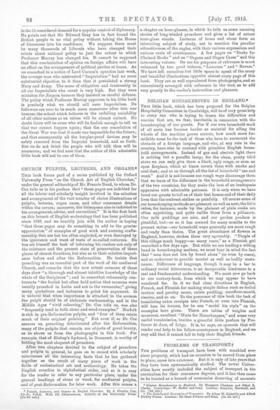CHURCH PULPITS, LECTERNS, AND ORGANS, Tins book forms part of
a series published by the Oxford University Press "on the Church Art of English Churches," under the general editorship of Mr. Francis Bond, to whom Dr. Cox tells us in his preface that " these pages are indebted for all the labour and scholarly insight involved in the selection and arrangement of the vast number of choice illustrations of pulpits, lecterns, organ cases, and other consonant details within the covers; moreover, the letterpress also is indebted to his arrangement, advice, and corrections." It is the first book on this branch of English ecclesiology that has been published since 1849, and we heartily join with the author in hoping 'that these pages may do something to add to the greater appreciation" of examples of good work and cunning crafts. manship that are but too often neglected, or even destroyed by the ignorance and want of taste of so-called restorers. He has set himself the task of informing his readers not only of the existence and the present state of preservation of these pieces of church furniture, but also as to their relative import- ance before and after the Reformation. He insists that preaching was an essential part of the work of the mediaeval Church, and remarks that the now extant sermons of those days show " a thorough and almost intuitive knowledge of the whole of the Scriptures " ; and be somewhat vehemently con- troverts "the foolish but often held notion that sermons were usually preached in Latin and not in the vernacular," giving many quotations and instances to point his argument. It is natural that when importance is attached to the sermon the pulpit should be of elaborate workmanship, and in the Middle Ages " vivid colouring," Dr. Cox tells us, was also " frequently used in both stone and wood examples." Norfolk is rich in pre-Reformation pulpits, and "four of them retain much of their original painting." But even if, as Dr. Cox assures us, preaching deteriorated after the Reformation, many of the pulpits that remain are objects of great beauty, as he shows us from the photographs in this book. For example, that of ,Bishop's Lydeard, in Somerset, is worthy of holding the most eloquent of preachers.
After two chapters devoted to the subject of preachers and pulpits in general, he goes on to record with scholarly minuteness all the interesting facts that he has gathered together as the result of many years of work in the fields of ecclesiastical art and archaeology. He takes the English counties in alphabetical order, and so it is easy for the reader to refer to any particular place, under the general headings of stone or wood, for mediaeval pulpits, and of post-Reformation for later work. After this comes a • Pulpits, Lecterns, and Organs in English, Churches. By J. Charles Cox, LL.D., F.S.A. With 155 Illustrations. Oxford: at the University Press. Vs. ea. net.] a chapter on hour-glasses, in which he tells us some amusing stories of long=winded preachers and gives e list of extant hour-glass stands. Lecterns of brass and stone form an interesting subject of study, not to mention the peculiar attractiveness of the eagles, with their various expressions and curious casts of countenance. A few pages on "Desks for Chained Books " and on " Organs and Organ Cases " end this interesting volume. Its use for purposes of reference is much enhanced by two good indexes, " Locorum " and " Rerum." We have left ourselves but little space to speak of the many and beautiful illustrations opposite almost every page of this book. They are so well reproduced from photographs, and so conveniently arranged with reference to the text, as to add very greatly to the reader's instruction and pleasure.


































 Previous page
Previous page